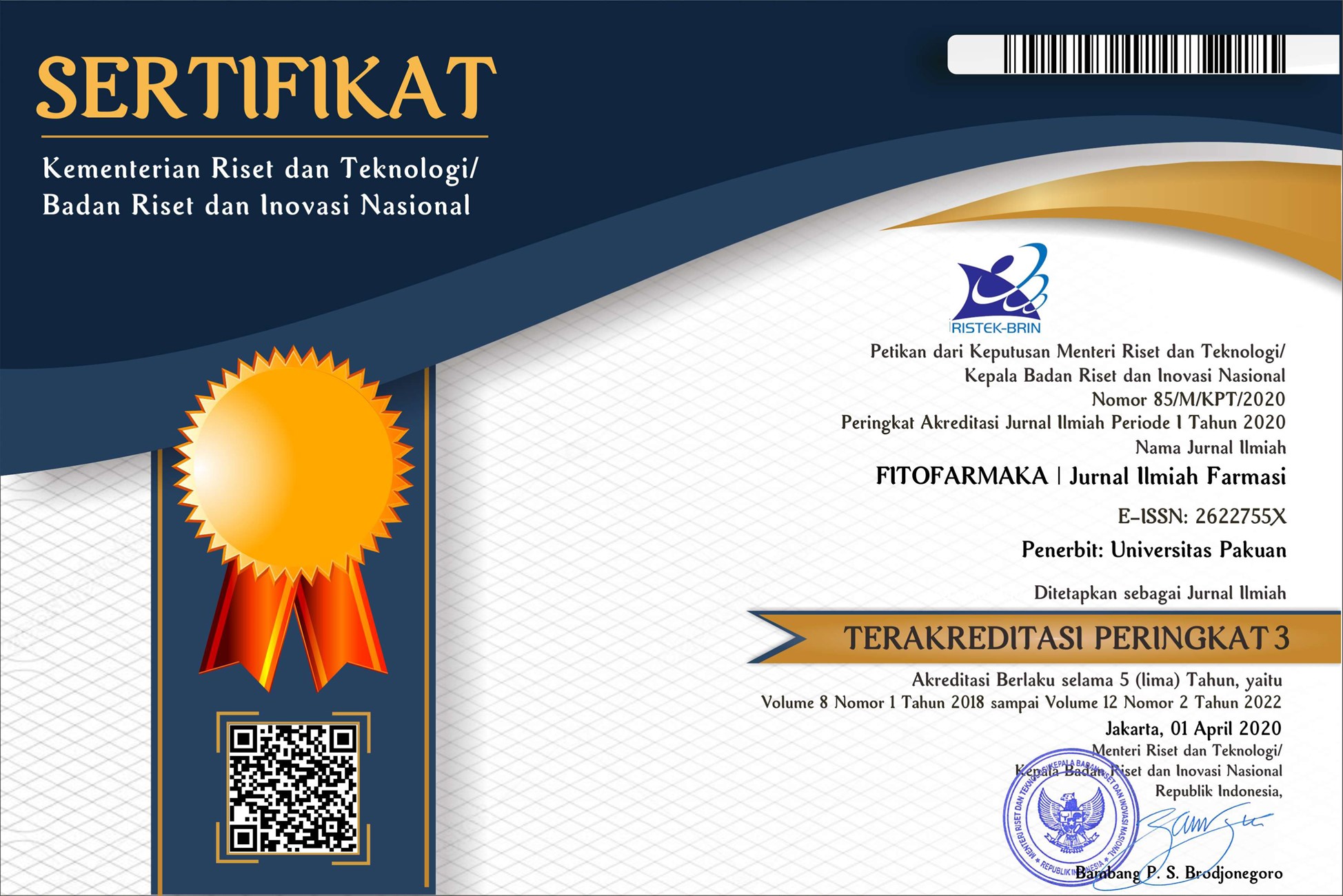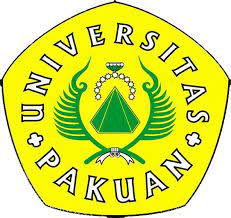Submissions
Registration and login are required to submit items online and to check the status of current submissions.
Already have a Username/Password for FITOFARMAKA: JURNAL ILMIAH FARMASI?
Go to Login
Author Guidelines
Author Guidelines
- FJIF publishes articles in medical and health professions education themes that are listed in the Focus and Scope section. Nevertheless, themes other than those which are listed in the Focus and Scope section would still be considered by the editorial board as long as they are still related.
- The manuscript should be prepared according to the following author guidelines in the MS Word (doc.; docx; rtf) article template format in English language
- All Authors must signed Statement of Originality. Statement of Orignality should be Uploaded as a Supplementary fileStatement of Orignality should be Uploaded as a Supplementary file.
- All manuscripts must be submitted to FJIF Editorial Office using Online Submission Service at the following URL address: Online Submission, where Author should register first as Author role. If authors have any problems on the online submission, please contact Editorial Office at the following email: fitofarmaka@unpak.ac.id.
- Manuscript typed on A4 paper with margin: upper 4 cm, left 3 cm, right 3 cm, and bottom 3 cm. The script is typed with the spacing of 1 spaces with a maximum length of 15 pages with one column format. The contents of the article are written in Times New Roman 12 pt.
- English article titles are written with specific, effective and preferably no more than 14 words. The title of the article should be informative, specific, concise, and contain keywords that describe the contents of the manuscript in its entirety. The title of the article is written in Times New Roman 12 pt, Bold and Centered.
- The name of authors is written in Times New Roman 12 pt and bold without the title and should not be abbreviated. If the author is more than one, separated by commas.
- Name of affiliation and email address wrote sequence starting from the first author with Times New Roman 12 pt, italic and space 1.
- Abstracts are written in Indonesia and English version. Abstract consisted of 1 paragraph, 150-250 words is preferably and written with Times New Roman 12 pt. The abstract should be clear, concise, and descriptive. Consider it the advertisement of your article. The abstract should tell the prospective reader what you did and highlight the key findings. This abstract should provide a brief background of the problem (preferably 1-2 sentences), clear objective of paper, research method in short, and a brief summary of results/findings, and short conclusion. The abstract should be precise and honest. Please follow word limitations (100-250 words)
- Keywords consist of 3-5 words crucial to the appropriate indexing of the papers, separated by semicolon.
- The sub-titles are written in capital letters (Times New Roman 12 pt bold).
- Introduction: Authors should state the objectives of the work at the end of introduction section. Before the objective, Authors should provide an adequate background (maximum 1 paragraph), and very short literatures survey/review in order to record the existing solutions/method, to show which is the best of previous researches, to show the main limitation of the previous researches, to show what do you hope to achieve (to solve the limitation), and to show the scientific merit or novelties of the paper. Avoid a detailed literature survey or a summary of the results. Do not describe literatures survey/review as author by author but should be presented as group of articles per method or topic reviewed which refers to some literatures.
- Research Methods: contains expositions in the form of paragraphs containing time and place of research, design, materials/research subjects, procedures/techniques of data collection, instruments, and data analysis techniques.
- Results and Discussion: Results should be clear and concise. The results should summarize (scientific) findings rather than providing data in detail. Please highlight differences between your results or findings and the previous publications by other researchers. The discussion it is the most important section of your article. Here you get the chance to sell your data. The Discussion should explore the significance of the results of the work, not repeat them.
- Conclusions, suggestions, and recommendations: Conclusions should only answer the objectives of the research. Tells how your work advances the field from the present state of knowledge. Without clear Conclusions, reviewers and readers will find it difficult to judge the work, and whether or not it merits publication in the journal. Do not repeat the Abstract, or just list experimental results. Provide a clear scientific justification for your work, and indicate possible applications and extensions. This conclusion should be provided as a paragraph. You should also suggest future experiments and/or point out those that are underway.
- The Quote using body note. Don't use the footnote.
- The bibliography contains the sources used as references in the study. Referral sources of at least 80% of the literature published in the last ten years is preferably. References used are primary sources of articles that exist in scientific journals or research reports (thesis, dissertation). The bibliography is written alphabetically with Times New Roman 12 pt, space 1, special indentation hanging by 1 cm. The rules of writing the bibliography follow the rules of American Psychological Association (APA) 7th edition (Must be use the reference manager, i.e., Mendeley, Zotero, EndNote, etc.). The minimum number of references should be 25 references.
- Tables and Figures/Illustrations - should be attached as an appendix and numbered accordingly. Please give marks in the article where the particular table or figure should be embedded. Authors are suggested to limit the number of tables and figures to maximum of 5.
Failure to follow instructions may result in publication delays if your manuscript is accepted.
Submission Preparation Checklist
As part of the submission process, authors are required to check off their submission's compliance with all of the following items, and submissions may be returned to authors that do not adhere to these guidelines.
- The submission has not been previously published, nor is it before another journal for consideration (or an explanation has been provided in Comments to the Editor).
- The submission file is in OpenOffice, Microsoft Word, or RTF document file format.
- DOI for online journal sources, or URL for the internet sources other than online journals, have been provided
- Manuscript typed on A4 paper with margin: upper 4 cm, left 3 cm, right 3 cm, and bottom 3 cm. The script is typed with the spacing of 1 spaces with a maximum length of 15 pages with one column format. The contents of the article are written in Times New Roman 12 pt; and all illustrations, figures, and tables are placed within the text at the appropriate points, rather than at the end.
- The text adheres to the stylistic and bibliographic requirements outlined in the Author Guidelines.
Copyright Notice
With the receipt of the article by FJIF Editorial Board and the decision to be published, the copyright regarding the article will be transferred to FJIF Journal.
FJIF has the right to multiply and distribute the article and every author is not allowed to publish the same article that was published in this journal.
All works published by the Journal can be used by everyone licensed under a Creative Commons Attribution-ShareAlike 4.0 International (CC BY-SA 4.0) license that allows others to use and share the work with an acknowledgment of the work's authorship and initial publication in this journal.

FITOFARMAKA: Jurnal Ilmiah Farmasi is licensed under a Creative Commons Attribution-ShareAlike 4.0 International License.
Updated - October 17th, 2023
Privacy Statement
The names and email addresses entered in this journal site will be used exclusively for the stated purposes of this journal and will not be made available for any other purpose or to any other party.
Author Fees
This journal charges the following author fees.
Article Submission: 0.00 (IDR)
Authors don't have to pay an Article submission Fee as part of the submission process.
Article Publication: 1000000.00 (IDR)
If this paper is accepted for publication, you will be asked to pay an Article Publication Fee to cover publications costs.
Payment is transferred through BNI Bank with 6010006053 in the name of Yayasan Pakuan Siliwangi Account, including proof of transfer
If you do not have funds to pay such fees, you will have an opportunity to waive each fee. We do not want fees to prevent the publication of worthy work.















